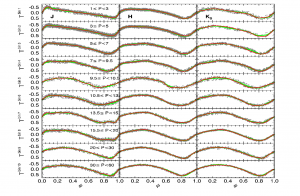 Measuring the mean magnitude or period of a Cepheid, however, can be a pretty demanding task in its own right. A Cepheid’s light curve looks different in different wavelengths (as shown in Figure 1, taken from Madore and Freedman 1991). The shorter-wavelength bands like the B and V-bands have light curves with larger amplitudes of variation and more asymmetry than the light curves in longer-wavelength near-infrared bands like J, H, and K. This makes it easier to detect and characterize the Cepheids in the B and V bands, but harder to accurately determine the mean magnitude of a Cepheid in those wavelengths, since we have to know accurately what phase of the light curve we are observing in order to get a good measurement of the mean magnitude. In practice, we often want to use measure the periods using light curves from shorter wavelengths and measure the mean magnitudes using light curves from longer wavelengths.
Measuring the mean magnitude or period of a Cepheid, however, can be a pretty demanding task in its own right. A Cepheid’s light curve looks different in different wavelengths (as shown in Figure 1, taken from Madore and Freedman 1991). The shorter-wavelength bands like the B and V-bands have light curves with larger amplitudes of variation and more asymmetry than the light curves in longer-wavelength near-infrared bands like J, H, and K. This makes it easier to detect and characterize the Cepheids in the B and V bands, but harder to accurately determine the mean magnitude of a Cepheid in those wavelengths, since we have to know accurately what phase of the light curve we are observing in order to get a good measurement of the mean magnitude. In practice, we often want to use measure the periods using light curves from shorter wavelengths and measure the mean magnitudes using light curves from longer wavelengths.
Read the full summary on Astrobites
Read the paper "New NIR light-curve templates for classical Cepheids" on astro-ph

